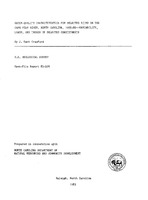Water-quality data for selected sites in the Cape Fear River basin collected by the U.S. Geological Survey, the North Carolina Department of Natural Resources and Community Development and the University of North Carolina at Chapel Hill are analyzed and interpreted in this report. Emphasis is given to the Cape Fear River at Lock 1 near Kelly, where data are most complete. Other data included in the report were collected from the Cape Fear River at Lillington, the Haw River near the Jordan Dam, and the Deep River at Moncure.
Available data indicate that concentrations of dissolved oxygen at study sites are almost always within U.S. Environmental Protection Agency criteria; however, on two sampling dates, the concentration of dissolved oxygen in the Cape Fear at Lock 1 fell slightly below the 5.0 mg/L recommended for fish populations. Measurements of pH from all stations were frequently below the lower limit of 6.5 pH units recommended for protection of freshwater aquatic life.
Major dissolved ions detected are sodium and bicarbonate. Sodium concentration averages 8.6 mg/L and bicarbonate averages 17.5 mg/L at Lock 1. Concentrations of dissolved substances and suspended sediment decrease in the downstream direction, presumably because the more heavily populated part of the basin is near the headwaters of the system.
Heavy metals, with the exceptions of cadmium and mercury, rarely exceed Environmental Protection Agency criteria for the protection of aquatic life. Concentrations of mercury in the Haw River, which exceed the recommended 0.20 mg/L needed to protect aquatic life, have frequently been reported by other authors. Several of the most toxic metals, arsenic, cadmium, and cobalt, are about five times more concentrated in water from the Haw River site than from other study sites in the basin. Iron and manganese frequently exceed North Carolina water-quality standards.
Available nitrogen averages 1.21 mg/L and available phosphorus averages 0.21 mg/L at Lock 1. Nuisance algal growths have not been identified as a problem in the river.
Comparisons of water-quality data for baseline (natural) and present conditions indicate that more than 50 percent of most dissolved substances and over 80 percent of certain forms of nitrogen and phosph6rus result from development.
Over the past 25 years, increases in concentrations of specific conductance, dissolved magnesium, dissolved sodium, dissolved potassium, dissolved sulfate, dissolved solids, and total nitrite plus nitrate nitrogen were detected in the Cape Fear River at Lock 1. Values for pH and dissolved silica are decreasing. Concentrations of most dissolved constituents at Lock 1 are increasing. These increases are statistically related to increases in population and manufacturing employment in the basin but are unrelated to agricultural activity.


